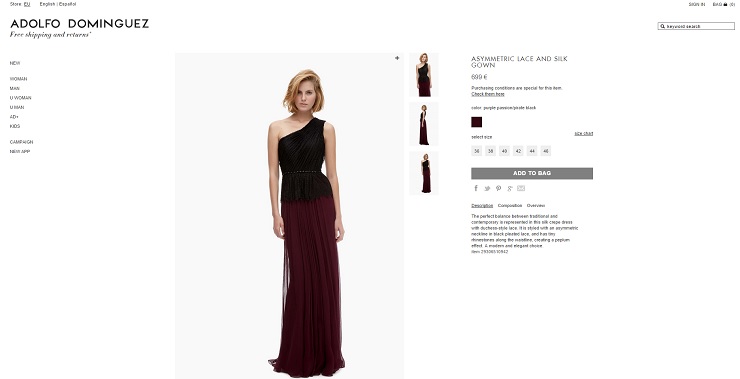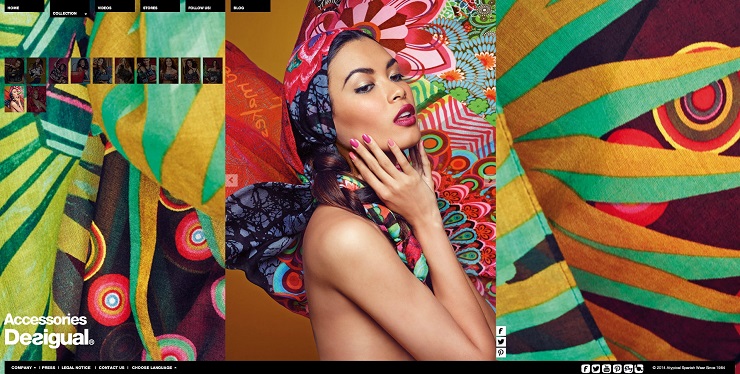Adolfo Dominguez
Adolfo Dominguez is a Spanish fashion designer that took over his father’s little fashion store in the 1970’s. Maybe you remember the suits in the 80’s series Miami Vice, they were designed by Adolfo Dominquez. He is the first Spanish fashion designer to open an own brand store in Madrid, that soon grew into a chain, and is now represented over the world.
E-commerce is a clear number one of the almost 700 stores in 35 countries. Their e-commerce has always been profitable. It has always been about stake something to get volume. The site has been ranked top 3 best e-commerce sites in Spain, and is ranked high in Google’s list of most searched fashion brands in Spain.

At Global e-Commerce Summit, Valeria Dominguez, e-Commerce and Omnichannel Manager at Adolfo Dominguez, shared some of her ideas. She has been involved in the launch of e-commerce in 25 EU countries with free delivery and returns. The logistics has been more efficient, 95 % of the packages are shipped the same business day. Their mobile site use responsive design, and the site has been redesigned to be optimized for tablets. New omnichannel projects has integrated every store to the central warehouse.
- It won’t work on the first attempt, be prepared to some resistance.
- Most people don’t have to buy clothes, it is about beauty, emotion, and feeling connected.
- Look at the photo evolution over the years. People look at the eyes first, that is something you need to pay for. Compare product images and model images and see the difference.
- Zoom with high quality is very important. When you can’t see or feel an item, you need to be able study it in detail online.
- Make shopping social. Women have always shopped in a group, get this on board. Share, review, and wish list are a few examples.
- Prefer not to be at the front of new technology. This is expensive, and not worth it.
- The customer is already omnichannel and come a far way, it is not a question if it is right. Just act.
- Make it comfortable for the client, not yourself. Fashion is an entertainment industry. Men don’t enjoy fashion, women do. If your target group are women, you probably know who the real boss is.
Desigual
With a yearly product of over 28 million products, Desigual is one of the Spanish fashion retailers with highest growth in the past years, new stores are opened every month. The company was founded in 1984, and has now more than 300 stores, and is represented in 11,000 multi-brand stores, and 2,500 shop-in-shops in more than 70 countries. E-commerce is available in 20 countries with more than 24 million visits the first six months 2014.

Desigual had an omnichannel approach already in 2011. A store was opened in Barcelona that year with a showroom, and a physical shopping area to empower e-commerce. Every product is only available in a few items in the store, the staff in the store has a tablet to guide the customer.
Elena Cusi Costa, Global e-Commerce Manager at Desigual, also shared a few ideas about their successful omnichannel journey. Sales has multiplied by 10 the last six years. E-commerce is now 10 % of the total sales.
- Customer first. Personalize, think about the customers different characteristics. Customers that are omni is worth more since the usually purchase more often, and for more money.
- The customer experience should be consistent, relevant, and contextual.
- Customers don’t think about channels, don’t have channel conflicts. Online influence is one of the primary driver of future store sales. Make sure that prizes are aligned, they should not have to be different.
- The staff in the store need to have the same or better information and technology as the customers.
- Upgrade the supply chain, ship from nearest, and send it where the customer wants it. Don’t forget to be flexible with returns so that the customer can do it where it suits them.
- Analyses are very important and useful. Measure and analyse a lot.
- Have some space for innovation, try to have the team in constant “beta mode”. Fail fast and learn fast.
There are different strategies to succeed in fashion online. It is always interesting to listen to those who have succeeded, and do it well. The number of returns and the cost for this is often debated for example. If you have several returns on the same product, you might want to ask yourself if the product information contains too little information or is inadequate in some way. If a garment is too large or small in size, it helps both buyer and seller if the customer can find this out before the order is done.
Finally a few words from Valeria Dominguez when it comes to staking on your e-commerce commitment – Fortune favours the bold.
